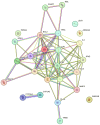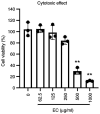Deciphering the anti‑influenza potential of Eucommiae Cortex based on bioinformatics analysis: In silico and in vitro experiments
- PMID: 40230620
- PMCID: PMC11995446
- DOI: 10.3892/etm.2025.12856
Deciphering the anti‑influenza potential of Eucommiae Cortex based on bioinformatics analysis: In silico and in vitro experiments
Abstract
Influenza infections damage the airway and induce the innate immune response that contributes to hyper-inflammation. Eucommiae Cortex (EC) enhances immune function and suppresses inflammation. To determine potential compounds and targets of EC associated with influenza, bioinformatics analyses and experimental verification were employed. The active compounds of EC were retrieved from the Traditional Chinese Medicine Systems Pharmacology database. The intersecting targets of EC and influenza were determined and examined using network pharmacology to analyze the relationship between the compounds and disease targets. The network identified three main compounds (quercetin, genistein and kaempferol) and four main targets (IL6, BCL2, IL1B and TNF). The ligand-target binding affinity was calculated by molecular docking, a computational method used in drug design to predict the interaction between the compound and protein target. The docking results revealed that kaempferol and TNF showed the strongest binding affinity. In vitro experiments confirmed the therapeutic effect of EC in influenza virus-infected Madin-Darby canine kidney cells. Collectively, the present study identified the active compounds and potential targets of EC in influenza and suggested EC as a future influenza treatment.
Keywords: Eucommiae Cortex; bioinformatics; influenza; molecular docking; network pharmacology; systems biology.
Copyright © 2025, Spandidos Publications.
Conflict of interest statement
The authors declare that they have no competing interests.
Figures








Similar articles
-
Anti-Influenza A Potential of Tagetes erecta Linn. Extract Based on Bioinformatics Analysis and In Vitro Assays.Int J Mol Sci. 2024 Jun 27;25(13):7065. doi: 10.3390/ijms25137065. Int J Mol Sci. 2024. PMID: 39000173 Free PMC article.
-
[Discovery and study on potential effect of herbal pair of Uncariae Ramulus cum Uncis-Eucommiae Cortex on pregnancy hypertension based on network pharmacology and molecular docking].Zhongguo Zhong Yao Za Zhi. 2020 Nov;45(22):5393-5402. doi: 10.19540/j.cnki.cjcmm.20200810.401. Zhongguo Zhong Yao Za Zhi. 2020. PMID: 33350198 Chinese.
-
Medioresinol from Eucommiae cortex improves myocardial infarction-induced heart failure through activation of the PI3K/AKT/mTOR pathway: A network analysis and experimental study.PLoS One. 2024 Sep 27;19(9):e0311143. doi: 10.1371/journal.pone.0311143. eCollection 2024. PLoS One. 2024. PMID: 39331625 Free PMC article.
-
A Network Pharmacology-Based Study on Vital Pharmacological Pathways and Targets of Eucommiae Cortex Acting on Osteoporosis.Biomed Res Int. 2022 Mar 31;2022:8510842. doi: 10.1155/2022/8510842. eCollection 2022. Biomed Res Int. 2022. PMID: 35402622 Free PMC article.
-
Identifying Active Compounds and Targets of Fritillariae thunbergii against Influenza-Associated Inflammation by Network Pharmacology Analysis and Molecular Docking.Molecules. 2020 Aug 25;25(17):3853. doi: 10.3390/molecules25173853. Molecules. 2020. PMID: 32854331 Free PMC article.
References
LinkOut - more resources
Full Text Sources
